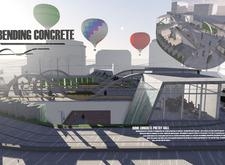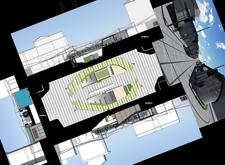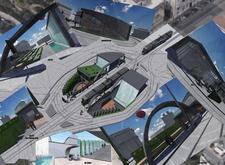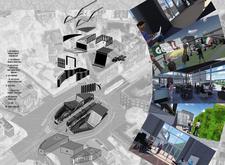5 key facts about this project
The primary function of the project is to create a cultural hub that fosters community interaction and artistic expression. It establishes a series of interconnected spaces that facilitate both individual reflection and communal gatherings, thus enhancing the social fabric of the surrounding area. The design aims to accommodate diverse activities, including poetry readings, performances, and leisure activities. By prioritizing these interactions, the architecture not only supports cultural programs but also encourages a sense of belonging among users.
The architectural design incorporates several important elements that contribute to its success. Curvilinear forms define the overall aesthetic, representing movement and dynamism. This choice of shape stands in stark contrast to the rigid lines typically associated with urban structures, allowing the building to harmonize with its environment. The curves are not merely aesthetic; they serve to guide movement through the space, creating an intuitive flow that invites exploration.
Materiality plays a significant role in the project's identity. The primary use of cast-in-place and precast concrete is central to its durability and versatility. Concrete becomes a tactile canvas that embodies the concept of bending, both physically and metaphorically. Its use is complemented by glass elements that provide transparency and natural light, enhancing the connection between the interior and exterior spaces. Additionally, the incorporation of vegetation through green walls and landscaped areas enriches the sensory experience, promoting biodiversity and contributing to the environmental sustainability of the project.
Interaction with the site is further facilitated by the integration of transport options, specifically through the alignment of tram lines with the architecture. This strategic decision underscores a commitment to accessibility, ensuring that the cultural hub is within easy reach of the community it serves. The layout includes outdoor seating areas and semi-public spaces designed for various activities, establishing a welcoming atmosphere that encourages spontaneous social engagement.
The unique design approach of this project lies in its ability to blend artistic vision with practical considerations. The architecture does not merely exist within the urban landscape; it actively participates in the life of the city. Through thoughtfully designed spaces, the project encourages users to engage with their surroundings, fostering a connection to both the architecture itself and the broader community.
Overall, "Bending Concrete" exemplifies the relationship between architecture and social dynamics within the urban environment. It represents a forward-thinking perspective that views buildings not just as physical structures, but as vital components of cultural and communal life. To explore further details, including architectural plans, sections, and innovative design ideas, consider delving deeper into the project presentation, where comprehensive insights into this architectural endeavor await.


























